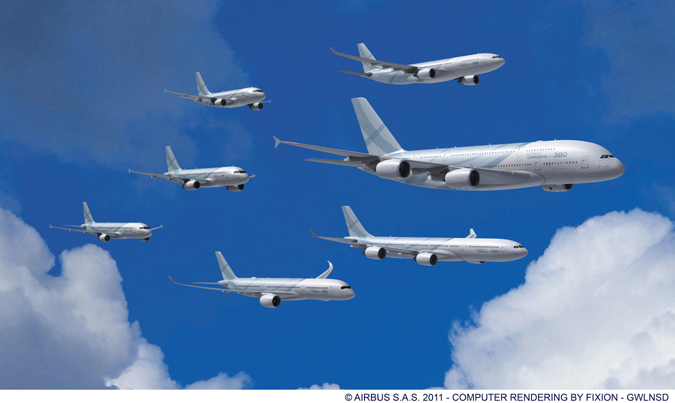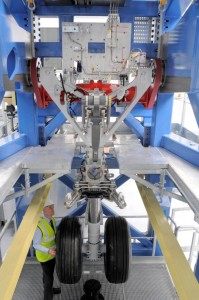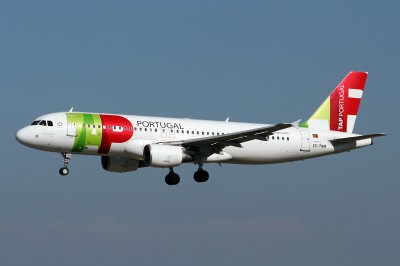
The new Airbus Corporate Jet livery. Click for much larger.
Airbus has revealed a new livery and brand for their line of corporate jets. The new livery reflects the look that many customers choose for their own private jets. Along with the new livery, Airbus Corporate Jets will have new nomenclature.
Instead of the standard “A” in front of an aircraft’s name (ie A330), it will be “ACJ” for the corporate jets (ie ACJ330).
’œAirbus has always been an innovator, regularly introducing improvements for the benefit of its customers, and we wanted to reflect this in our corporate jet family by introducing new branding, colours and names that provide a fresher and more modern look,’ declares Airbus Chief Operating Officer, Customers, John Leahy. ’œOne of our greatest strengths is having the world’s most modern aircraft family, and this is reflected in the new Airbus corporate jet branding,’ he adds.
Although the ACJ318 to ACJ320 are the more popular models, customers are able to order aircraft as large as the ACJ380. To date, there have been 170 Airbus Corporate Jets sold, flying on every continent, including Antarctica.

Four Airbus A380s at Toulouse. Click for larger.
What a great areal shot. Here you have four Airbus A380s at Toulouse, France. They will be delivered to Qantas, Emirates, Korean Air and China Southern.
Image by Weiyi Shi via Airliners.net with permission

The first landing gear for the Airbus A350 has been installed. Photo from Airbus. Click for larger.
Sorry time is making me go super lazy on this one and copy/paste the official Airbus press release with the photo:
The first A350 XWB nose landing gear produced by Liebherr Aerospace has been successfully installed in the A350 XWB landing gear systems test facility in Filton (UK).
In the coming weeks, the main landing gear supplied by Messier-Dowty will be installed and preliminary testing of all three landing gear legs will start. Full integration testing will begin with the entry into service of the facility towards the end of 2011. These tests are carried out to demonstrate reliability and maturity in addition to providing evidence for certification, especially with regards to the extension-retraction, braking and steering systems.
The test facility, called « landing gear zero », is part of a series of integration test benches specifically developed to test the A350 XWB systems in order to ensure that the aircraft meets the highest standards of in-service reliability from day one. Other A350 XWB system integration tests facilities such as this one are ’œcabin zero’ for testing the integration of cabin systems into the cabin structure and ’œaircraft zero’ known also as the ’œiron bird’ for testing the integration of the hydraulic, electric and flight control systems.

Cockpit of an Airbus A320
What does the cockpit of the future look like? New technology? Fewer pilots? Maybe no pilots? I don’t know if people will ever be ready for no human to have some sort of control over their airplane, but maybe they will be ok letting computers take over a bit more.
Recently, Airbus has taken another step towards airplane automation. Now, when two airplanes get too close, the Traffic alert and Collision Avoidance System (TCAS) will sound an alarm, the pilot will check out the situation and make needed adjustments. Many times, the system can provide false alarms or pilots can over-react to the alarm. Aibus’ new system will automatically adjust a plane’s altitude to avoid a collision. This will reduce false alarms and increase safety. For those that feel pilots should have more control — no worries. They are able to shut off the automated system and fly manually if they need to.
To see some quotes from Airbus and see what Boeing thinks, check out my story on AOL Travel News.

TAP Portugal Airbus A320 (CS-TNM)
So what the heck does “TAP” stand for? When the airline was established in 1945 it stood for Transportes Areos Portugueses. In 1979 the name was changed to TAP Air Portugal and finally it was simplified to just TAP Portugal.
TAP has an all Airbus fleet of A319, A320, A321, A330 and the A340. They also have 12 Airbus A350s on order. The airline flies to 65 destinations in 31 countries via their fleet of 66 aircraft. They also run a regional airline, called PGA, with 16 additional aircraft.
The livery overlaps the TAP on the front of the fuselage and mostly just has the “P” on the tail. This gives it a clean and unique look, especially with the “TAP PORTUGUAL” going vertically up the tail.
Image: Guido Haesevoets




